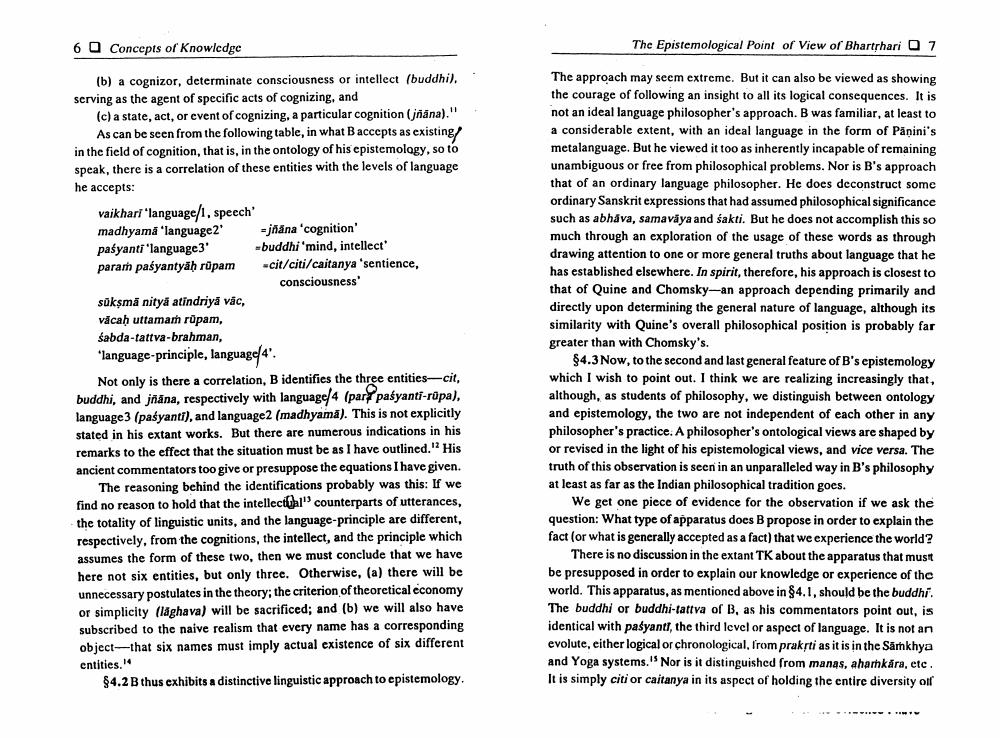________________
6 Concepts of Knowledge
(b) a cognizor, determinate consciousness or intellect (buddhi). serving as the agent of specific acts of cognizing, and
(c) a state, act, or event of cognizing, a particular cognition (jñāna)." As can be seen from the following table, in what B accepts as existing/ in the field of cognition, that is, in the ontology of his epistemology, so to speak, there is a correlation of these entities with the levels of language he accepts:
vaikhari 'language/1, speech' madhyama 'language2' pasyanti 'language3' param pasyantyähḥ rūpam
=jñāna 'cognition' -buddhi 'mind, intellect" -cit/citi/caitanya 'sentience, consciousness'
sükşma nityă atîndriyā vāc, vācaḥ uttamaṁ rūpam, sabda-tattva-brahman, *language-principle, language/4".
Not only is there a correlation, B identifies the three entities-cit, buddhi, and jñāna, respectively with language/4 (par pasyanti-rūpa), language3 (pasyanti), and language2 (madhyama). This is not explicitly stated in his extant works. But there are numerous indications in his remarks to the effect that the situation must be as I have outlined."2 His ancient commentators too give or presuppose the equations I have given.
The reasoning behind the identifications probably was this: If we find no reason to hold that the intellectual" counterparts of utterances, the totality of linguistic units, and the language-principle are different, respectively, from the cognitions, the intellect, and the principle which assumes the form of these two, then we must conclude that we have here not six entities, but only three. Otherwise, (a) there will be unnecessary postulates in the theory; the criterion of theoretical economy or simplicity (laghava) will be sacrificed; and (b) we will also have subscribed to the naive realism that every name has a corresponding object that six names must imply actual existence of six different entities.14
$4.2 B thus exhibits a distinctive linguistic approach to epistemology.
The Epistemological Point of View of Bhartṛhari 7
The approach may seem extreme. But it can also be viewed as showing the courage of following an insight to all its logical consequences. It is not an ideal language philosopher's approach. B was familiar, at least to a considerable extent, with an ideal language in the form of Panini's metalanguage. But he viewed it too as inherently incapable of remaining unambiguous or free from philosophical problems. Nor is B's approach that of an ordinary language philosopher. He does deconstruct some ordinary Sanskrit expressions that had assumed philosophical significance such as abhava, samaväya and sakti. But he does not accomplish this so much through an exploration of the usage of these words as through drawing attention to one or more general truths about language that he has established elsewhere. In spirit, therefore, his approach is closest to that of Quine and Chomsky-an approach depending primarily and directly upon determining the general nature of language, although its similarity with Quine's overall philosophical position is probably far greater than with Chomsky's.
§4.3 Now, to the second and last general feature of B's epistemology which I wish to point out. I think we are realizing increasingly that, although, as students of philosophy, we distinguish between ontology and epistemology, the two are not independent of each other in any philosopher's practice. A philosopher's ontological views are shaped by or revised in the light of his epistemological views, and vice versa. The truth of this observation is seen in an unparalleled way in B's philosophy at least as far as the Indian philosophical tradition goes.
We get one piece of evidence for the observation if we ask the question: What type of apparatus does B propose in order to explain the fact (or what is generally accepted as a fact) that we experience the world? There is no discussion in the extant TK about the apparatus that must be presupposed in order to explain our knowledge or experience of the world. This apparatus, as mentioned above in §4.1, should be the buddhi". The buddhi or buddhi-tattva of B, as his commentators point out, is identical with pasyanti, the third level or aspect of language. It is not an evolute, either logical or chronological, from prakṛti as it is in the Samkhya and Yoga systems. Nor is it distinguished from manas, ahamhkāra, etc. It is simply citi or caitanya in its aspect of holding the entire diversity off




